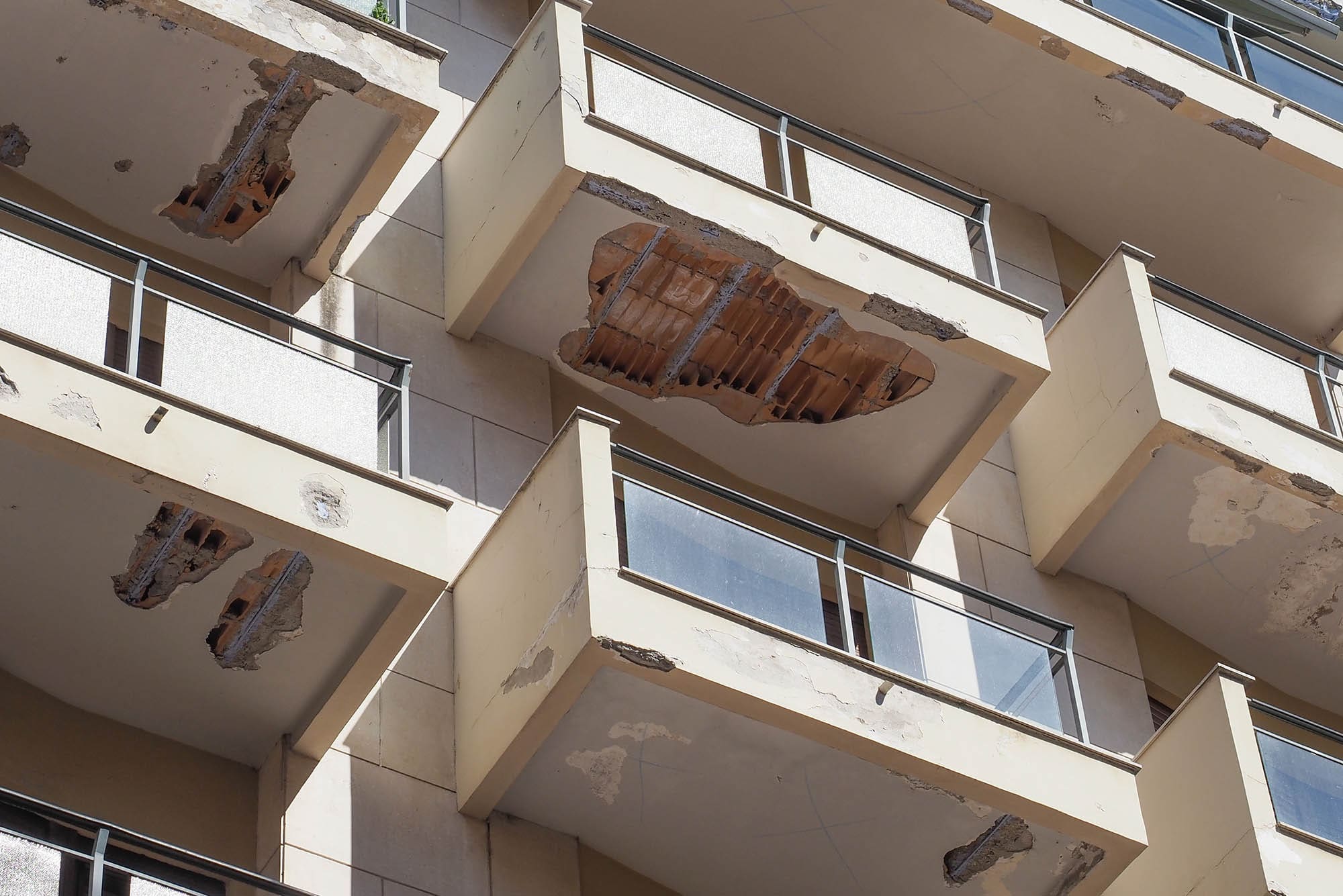Top Warning Signs of Balcony Damage Landlords Shouldn’t Ignore

Table of Contents
How Can You Spot Water Damage on a Balcony?
What Are the Dangers of Rust on Metal Components?
What Should You Do If You Notice Cracks in Balcony Surfaces?
FAQ Section: Top Questions & Answers
As a landlord, maintaining safe and structurally sound balconies is crucial for both tenant safety and regulatory compliance. In California, SB 326 inspections for multifamily properties and SB 721 inspections for decks, balconies, and other elevated structures are required to ensure safety. Early identification of balcony damage can prevent costly repairs and serious accidents. In this guide, we’ll highlight the most common balcony damage signs and why landlords need to act fast to address them.
1. How Can You Spot Water Damage on a Balcony?
One of the most common and dangerous forms of balcony deterioration is water damage. Left untreated, water can seep into cracks, weaken the structural components, and cause significant damage.
Signs of Water Damage:
- Cracks in the surface: Even small cracks can allow water to penetrate and worsen over time.
- Pooling water: Poor drainage can lead to standing water, which accelerates deterioration.
- Discoloration or staining: Water stains or efflorescence (a white, powdery substance) on concrete or brick indicate trapped moisture.
Why It Matters:
Water damage can lead to structural weakening and compromise the balcony’s load-bearing capacity. Regular balcony inspections and immediate repairs can prevent long-term issues.
2. What Are the Dangers of Rust on Metal Components?
Balconies with metal railings, brackets, or support beams are prone to rust if exposed to moisture over time. Rust can weaken these components, posing a safety hazard for tenants.
Signs of Rust:
- Reddish-brown spots on metal surfaces.
- Flaking or pitting on metal parts.
- Loose or wobbly railings caused by corrosion.
Why It Matters:
Rust can quickly spread and weaken metal supports and railings, increasing the risk of collapse or serious accidents. Under SB 326 and SB 721 inspections, any rusted metal elements must be repaired or replaced to meet safety standards.
Contact DrBalcony for a professional inspection!
Ensure the safety of your balcony and living space with DrBalcony – We’re a Tech Engineering firm that specializes in California SB326 & SB721 balcony inspections. Over 3000+ completed projects in California.
Request A Free EstimateClick To Call
3. What Should You Do If You Notice Cracks in Balcony Surfaces?
Cracks in a balcony’s concrete or wood surface may seem minor at first, but they can signal deeper structural issues. Hairline cracks may develop into larger problems if ignored.
Signs of Cracks:
- Hairline cracks: Small cracks that appear on the surface, especially in concrete or tile, should be closely monitored.
- Large, visible cracks: These indicate serious structural stress and require immediate attention.
Why It Matters:
Cracks allow water to penetrate, leading to moisture damage and potential collapse. Structural cracks are often flagged during deck inspections or balcony inspection reports, so it’s crucial to address them before inspections or tenant complaints.
4. How Can You Identify Signs of Rot in Wooden Balconies?
Wooden balconies are particularly vulnerable to rot, especially in humid climates or areas with frequent rain. If left untreated, rot can destroy the structural integrity of the balcony.
Signs of Rot:
- Soft or spongy wood: If the wood feels soft when pressed, it’s likely rotting from within.
- Discoloration or dark spots: These can indicate moisture buildup and early-stage rot.
- Cracked or split wood: Splitting wood may signal advanced rot, requiring immediate repair or replacement.
Why It Matters:
Rotting wood weakens the entire structure, increasing the likelihood of balcony failure. Regular inspections and treatments can prevent wood rot, protecting both tenants and the property.
5. How Can You Tell If the Balcony Railings Are Unsafe?
Balcony railings are a key safety feature, but they are often overlooked when assessing balcony stability. Weak or damaged railings can lead to serious accidents.
Signs of Unsafe Railings:
- Loose or wobbly railings: Railings that move when pushed indicate weak connections.
- Corroded or rusted fasteners: Rusty screws or bolts can no longer securely hold the railing.
- Visible gaps between railings and the balcony edge: This may signal poor installation or long-term wear.
Why It Matters:
Balcony railings are a critical safety feature, especially on high-rise buildings. Loose railings are a liability, and landlords are responsible for ensuring they meet safety standards under SB 721 inspections.
6. What Should You Do If You Notice Sagging or Uneven Balconies?
A sagging or uneven balcony is a serious structural issue that requires immediate action. This could signal compromised support beams or weak load-bearing elements.
Signs of Sagging or Uneven Balconies:
- Visible tilting or dipping of the balcony surface.
- Gaps between the balcony and the exterior wall.
- Uneven surfaces when you place objects on the balcony.
Why It Matters:
A sagging balcony is a red flag for structural failure. Addressing these issues quickly can prevent collapse and ensure compliance with SB326 inspection and SB721 inspection balcony inspection regulations.
7. Why Is Regular Balcony Inspection Essential for Landlords?
Regular balcony inspections are not just recommended—they are required by law in California for multi-family residential buildings. Under SB 326 and SB 721, landlords must have balconies and elevated exterior structures inspected every six years. Failing to comply with these regulations can result in fines, legal action, and tenant injuries.
Benefits of Regular Inspections:
- Prevents costly repairs: Early detection of damage can save thousands in repair costs.
- Ensures tenant safety: A well-maintained balcony reduces the risk of accidents.
- Meets legal requirements: Regular inspections help landlords avoid fines and potential liability.
Why It Matters:
Routine balcony inspections not only protect tenants but also ensure compliance with local safety laws. Staying ahead of balcony inspection reports and proactively addressing issues before they worsen can save landlords significant time and money.
Contact DrBalcony for a professional inspection!
Ensure the safety of your balcony and living space with DrBalcony – We’re a Tech Engineering firm that specializes in California SB326 & SB721 balcony inspections. Over 3000+ completed projects in California.
Request A Free EstimateClick To Call
As a landlord, ensuring that your property’s balconies are in top condition is critical for tenant safety and regulatory compliance. Watch out for key signs of damage, including water damage, rust, cracks, and loose railings. Regular SB 326 inspections and SB 721 inspections are necessary to maintain safety and prevent costly liabilities.
If you’re a landlord looking to ensure your property complies with California’s balcony safety regulations, DrBalcony offers FREE consultations and balcony inspection reports to help you stay on top of maintenance and compliance. Don’t wait until it’s too late—schedule a balcony inspection today and safeguard your property for years to come.
FAQ Section: Top Questions & Answers
My property is well-maintained. Do I really need SB-326/SB-721 inspections?
YES! Even with excellent maintenance, hidden issues can develop due to construction errors, material flaws, or severe weather exposure. Inspections are about ensuring those don’t turn into major problems.
Our balconies were inspected a few years ago – isn’t that enough?
Unfortunately, no. California laws mandate inspections on a set schedule, often every 6 years. Deterioration can happen quickly, making regular assessments essential.
Can I use my regular handyman for the balcony inspection?
It’s not recommended. Unless they hold specific licenses (architect, structural engineer, etc.) their inspection won’t be considered valid for SB-326/SB-721 compliance.
What if the inspection uncovers major issues?
First, don’t panic! Early detection often means less extensive (and expensive) repairs are needed. Work with your inspector to prioritize fixes, and explore if they offer repair services for a streamlined solution.
I’m worried about the cost of inspections. Are there any resources to help?
Start by getting detailed quotes from multiple companies. Factor in that proactive inspections help you avoid even bigger costs down the line due to neglected problems. Some property management associations offer guidance on budgeting for balcony compliance.
FAQ Section: Top Questions & Answers
Testimonials
Hear It From Our Customers
-
List Item #1 -
List Item #1 -
List Item #1 -
List Item #1 -
List Item #1
Jose Botello
I started off by doing 1 inspection with them back in June because I knew it needed work done. Now, they’ve completed 2 of my properties and have 2 more inspections coming up this month. All great so far! They’re great at keeping me updated
-
List Item #1 -
List Item #1 -
List Item #1 -
List Item #1 -
List Item #1
Augusto Monroy
I would like to share the fact that this company has been extremely honest and helpful with this challenging project. Balcony and walk way repairs are very expensive, so you want the very best professionals next to you
-
List Item #1 -
List Item #1 -
List Item #1 -
List Item #1 -
List Item #1
Giselle Valerio
Greg was very helpful in explaining the entire process. They walked me through everything and helped me keep both of my properties in compliance!

